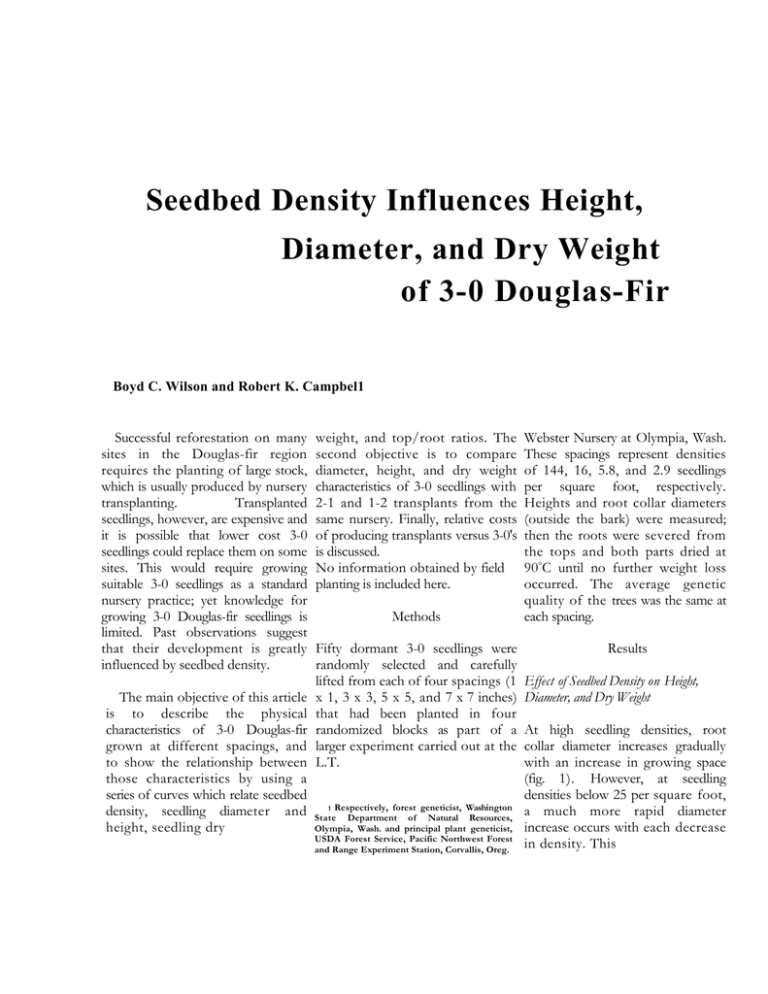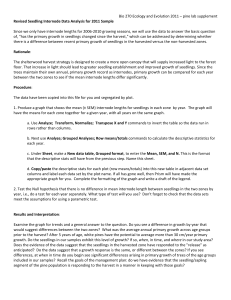Seedbed Density Influences Height, Diameter, and Dry Weight of 3-0 Douglas-Fir
advertisement

Seedbed Density Influences Height, Diameter, and Dry Weight of 3-0 Douglas-Fir Boyd C. Wilson and Robert K. Campbel1 Successful reforestation on many sites in the Douglas-fir region requires the planting of large stock, which is usually produced by nursery transplanting. Transplanted seedlings, however, are expensive and it is possible that lower cost 3-0 seedlings could replace them on some sites. This would require growing suitable 3-0 seedlings as a standard nursery practice; yet knowledge for growing 3-0 Douglas-fir seedlings is limited. Past observations suggest that their development is greatly influenced by seedbed density. The main objective of this article is to describe the physical characteristics of 3-0 Douglas-fir grown at different spacings, and to show the relationship between those characteristics by using a series of curves which relate seedbed density, seedling diameter and height, seedling dry weight, and top/root ratios. The second objective is to compare diameter, height, and dry weight characteristics of 3-0 seedlings with 2-1 and 1-2 transplants from the same nursery. Finally, relative costs of producing transplants versus 3-0's is discussed. No information obtained by field planting is included here. Methods Fifty dormant 3-0 seedlings were randomly selected and carefully lifted from each of four spacings (1 x 1, 3 x 3, 5 x 5, and 7 x 7 inches) that had been planted in four randomized blocks as part of a larger experiment carried out at the L.T. 1 Respectively, forest geneticist, Washington State Department of Natural Resources, Olympia, Wash. and principal plant geneticist, USDA Forest Service, Pacific Northwest Forest and Range Experiment Station, Corvallis, Oreg. Webster Nursery at Olympia, Wash. These spacings represent densities of 144, 16, 5.8, and 2.9 seedlings per square foot, respectively. Heights and root collar diameters (outside the bark) were measured; then the roots were severed from the tops and both parts dried at 90°C until no further weight loss occurred. The average genetic quality of the trees was the same at each spacing. Results Effect of Seedbed Density on Height, Diameter, and Dry Weight At high seedling densities, root collar diameter increases gradually with an increase in growing space (fig. 1). However, at seedling densities below 25 per square foot, a much more rapid diameter increase occurs with each decrease in density. This Relation of Height and Diameter to Seedling Dry Weights Measurements of height (h) and diameters (d) of seedlings and the products of height times diameter-squared (h x d2) were related to seedling dry weights by regression at each of the spacings and all spacings combined. Height alone was not a good predictor of dry weight (fig. 2). In the equations used to predict dry weights within the separate spacing trend continues to the widest than is height. Diameter range in classes, h x d2 was sometimes a spacing in the experiment (2.9 the experiment is 88 percent of better predictor than diameter seedlings per square foot), which the mean diameter while height indicates that even at this wide range is only 44 percent of the spacing (7" x 7"), there is still average height, a 2-to-1 ratio. Dry competition between seedlings. weight of tops and roots follows Curves for diameter and height the same trend with spacing as are similar, but diameter is more height and diameter, i.e., decreasing as density increases (table 1). severely affected by plant density of height measurement cannot be justified by the small increase in precision. For all spacings, h x d2 was responsible for 80, 94, and 91 percent of the variation in roots, tops, and total dry weight. Of the equations used to predict seedling weights for all spacings, the one based on diameter alone was best for explaining variation in dry weight (fig. 3). The equations for relating diameter to root, top, and total dry weight are: Tops= Y=-56.68 + 23.15 x+0.53x 2 +0.11x3 Roots = Y = 56.80-27.07 x +5.13x2 -0.17x3 Total = Y = 0.14 -3.39 x +5.66x2 0.06x 3 WHERE per square foot as transplants. Two limitations to the data should be kept in mind when evaluating these comparisons: 1) The 1-2 and 2-1 transplants were grown several years prior to the spacing experiment which may introduce different year effects, and 2) although the 2-1 and 1-2 transplants come from identical seed lots, the 3-0 seedlings are from a different source. Table 1 shows that traits of 3-0's are mainly intermediate to the two transplant types. When grown to comparable stem diameters, 3-0's are shorter than 1-2's and taller than 2-1's; their top/root ratios are smaller than 1-2's and larger than 2­ 1's. They appear to be heavier than either type. Apparently within the seedling densities investigated, bed density We wish to emphasize that the cannot be manipulated to ratios based on diameter are much more accurately estimated than Relation of Height and Diameter to those based on height. The latter Top/Root Ratio should be used only in cases where By referring to figures 2 or 3, diameter measurement would be one can easily calculate a top/root either very expensive or impossible. ratio for any specified height or diameter of a 3-0 Douglas-fir Transplants Compared to 3-0 seedling. For example, a tree with a Seedlings diameter of 10 mm yields a root dry weight of 13 grams and a top Some preliminary knowledge of weight of 34 grams (fig. 3). the worth of 3-0 stock was acquired Dividing 34 by 13 equals a top/root through comparison with 1-2 and 2­ ratio of 2.6. The curves for top/root 1 transplanted seedlings grown at the ratios in figure 4 were developed by Webster Nursery. The transplant data came from four and three this method. In both curves in figure 4, seedling lots, respectively, of 25 seedlings of intermediate size have plants each.2 These seedlings were minimum ratios. That is, within grown at about 50 per square foot as the height or diameter range of usual 1-0's or 2-0's and at about eight planting stock, unless the nurseryman uses additional cultural 2Anderson, H.W. 1965. State of Washington, techniques, ratios less than about Department of Natural Resources. Unpublished 2.6 or 2.7 would not be realized. data. Y =predicted dry weight in decigrams X = root collar diameter in millimeters produce 3-0 seedlings with the same characteristics as transplant stock. However, we are suggesting that an intermediate type with an approximate average height of 55 cm., a diameter of 9 mm., and a top/root ratio of 2.7 can be produced if there is a need, and if production costs are acceptable. To grow this type in the Webster Nursery, we recommend sowing for eight to 10 seedlings per square foot (table 1). The devel­ opment of appropriate cultural techniques, such as horizontal and vertical root pruning, would probably lead to improvements in the desired quality. Cost Comparisons of 3-0 Seedlings Versus Transplants At the Webster Nursery, in 1969-70, costs for 1-2 and 2-1 Douglas-fir transplants were $60 and $47 per thousand, respective­ ly. Costs of 3-0 evergreen seedlings (of species other than Douglas-fir) were $26 per thousand. Consequently, the smallest apparent saving by using 3-0 stock is $21 per thousand. This apparent saving is probably overestimated, especially if nursery bed space is at a premium. One thousand seedlings (3-0) produced at eight per square foot require 125 square feet of bed space in each of 3 years. In contrast, 2-1 transplants require 20 square feet in each of the first 2 years when grown at the normal 50 trees per square foot. If transplanted at a density of eight seedlings per square foot, they require an additional 125 square feet per thousand trees for another year. The total is 165 square feet for 3 years. Using the same arithmetic, 1-2 seedlings require 270 square feet. The average bed space per thousand trees per year is, then, 125, 90, and 55 square feet for 3-0, 1-2, and 2-1 seedlings, respectively. Obviously, where bed space is limited, transplants must be grown if the maximum number of 3-year-old trees is to be produced. Conclusions The conclusions reached can be summarized as follows: Invitation to Readers procedure which might be helpful to Every reader is a potential au­ someone else. thor of an article for Tree Planters' You will facilitate our work if Notes. Please write in if you have developed or found useful a new you type your article double space. clear, glossy print piece of equipment, a nursery Send photographs or black ink drawings if operation, a technique or method possible, to increase readers' interest of planting or seeding trees, handling or packing seedlings, and understanding. Black and improving seedling growth, or site white negatives or color slides preparation; or a seed collecting, are also acceptable, processing, or storage 1. Nursery spacing of Douglas-fir 3­ 0 seedlings affects both height and diameter even at densities as low as 2.9 seedlings per square foot. Diameter is affected more by spacing than is height. 2. Height and diameter can both be used to predict dry weight of seedling tops and roots. Diameter is a much better predictor of dry weight than is height. 3. Within the probable diameter and height range of normal planting stock, top/root ratios will likely not fall below 2.6. 4. Regardless of spacing, the Douglas-fir 3-0 seedlings did not have the same characteristics as 2-1 or 1-2 transplants. 5. Douglas-fir 3-0 seedlings use more cumulative bed space than transplants of the same age but are cheaper to produce. 6. Growing Douglas-fir 3-0 seedlings at eight to 10 seedlings per square foot is suggested to produce optimum planting stock. and will be returned as soon as glossy prints can be made. Send suggestions and articles to Chief, Forest Service (Attn. Tree Planters' Notes), U.S. Department of Agriculture, Washington, D.C. 20250. Permission is granted to reproduce any articles. Authors will be furnished a reasonable number of copies of their articles if they wish.





